TRIGONOMETRIC RATIOS SIN COS AND TAN
Subscribe to our ▶️ YouTube channel 🔴 for the latest videos, updates, and tips.
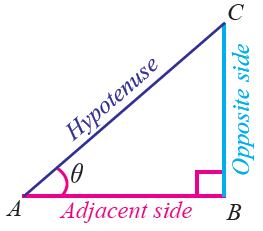
The formulas given below can be used to find the trigonometric ratios sin, cos and tan.
sin θ = Opposite side / Hypotenuse
cos θ = Adjacent side / Hypotenuse
tan θ = Opposite side / Adjacent side
Example 1 :
Find the value of cos C.

Solution :
90° is at ∠A. So the side which is opposite to 90° is known as hypotenuse. The side which is opposite to ∠C is known as opposite side. The remaining side is known as adjacent side.
So, we have
BC = Hypotenuse = 17
AB = Opposite side = 8
AC = Adjacent side = 15
Then,
cos C = Adjacent side / Hypotenuse
cos C = AC/BC
cos C = 15/17
Example 2 :
Find the vale of sin A.

Solution :
90° is at ∠B. So the side which is opposite to 90° is known as hypotenuse. The side which is opposite to ∠A is known as opposite side. The remaining side is known as adjacent side.
So, we have
AC = Hypotenuse = 65
BC = Opposite side = 33
AB = Adjacent side = 56
Then,
sin A = Opposite side / Hypotenuse
sin A = BC/AC
sin A = 33/65
Example 3 :
Find the value of tan B.

Solution :
90° is at ∠A. So the side which is opposite to 90° is known as hypotenuse. The side which is opposite to ∠B is known as opposite side. The remaining side is known as adjacent side.
So, we have
BC = Hypotenuse = 5
AC = Opposite side = 4
AB = Adjacent side = 3
Then,
tan B = Opposite side / Adjacent side
tan B = AC/AB
tan B = 4/3
Example 4 :
In the triangle below, what is the sum of a and b.
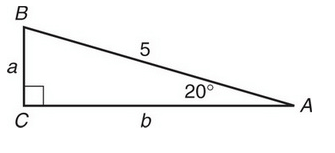
Solution :
Hypotenuse (AB) = 5, Opposite side (BC) = a and adjacent side (AC) = b
|
sin 20 = BC/AB sin 20 = BC / 5 BC = 5(sin 20) BC = 5(0.3420) BC = 1.710 |
cos 20 = AC/AB cos 20 = AC / 5 AC = 5(cos 20) AC = 5(0.939) AC = 4.698 |
a = 1.710 and b = 4.698
a + b = 1.710 + 4.698
= 6.408
So, the sum of a and b is 6.408.
Example 5 :
x + y = 90° and cos y = 7/13, what is the value of sin x ?
Solution :
x + y = 90°
x and y are complementary angles.
y = 90 - x
cos y = cos (90 - x)
Using cofunction identities,
cos y = sin x
cos y = 7/13
sin x = 7/13
Example 6 :
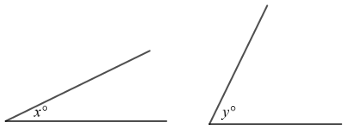
The angles shown above are acute and sin x = cos y. If x = 3z + 5 and y = 2z - 10. What is the value of z ?
a) 15 b) 17 c) 19 d) 37
Solution :
sin x = cos y
sin (3z + 5) = cos (2z - 10)
sin (3z + 5) = sin (90 - (2z - 10))
3z + 5 = 90 - 2z + 10
3z + 5 = 100 - 2z
3z + 2z = 100 - 5
5z = 95
z = 95/5
z = 19
So, the value of z is 19.
Example 7 :
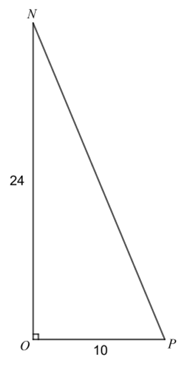
Triangle NOP above, point K (not shown) lies on NP. What is the value of cos (∠KOP) - sin (∠NOK) ?
Solution :
cos (∠KOP) - sin (∠NOK)
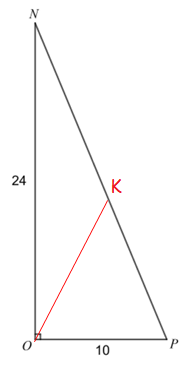
∠KOP and ∠NOK are complementary angles.
∠KOP + ∠NOK = 90
∠NOK = 90 - ∠KOP
sin ∠NOK = sin (90 - ∠KOP)
sin ∠NOK = cos ∠KOP ---(1)
Applying (1) in given
Given, cos (∠KOP) - sin (∠NOK) ----(2)
= cos (∠KOP) - cos (∠KOP)
= 0
So, the answer is 0.
Example 8 :
In a right triangle, one angle measure w, where sin w = 5/13. What is cos (90 - w)?
Solution :
sin w = 5/13
cos w = sin (90 - w) similarly, cos (90 - w) = sin w
Then the value of cos (90 - w) = 5/13
Example 9 :
In a triangle above ABC is similar to triangle DEF and ∠B = ∠E. What is the value of tan F ?
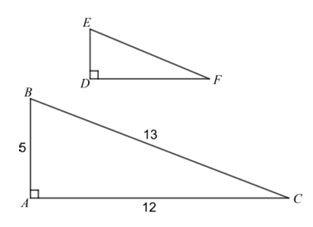
Solution :
If ∠B = ∠E, then ∠F = ∠C
tan C = Opposite side / adjacent side
Opposite side = 5, adjacent side = 12
tan C = 5/12
tan F = 5/12
Example 10 :
Triangle ABC, the measure of ∠C is 90 and AB = 26. If sin B = 5/13, what is the value of BC ?
Solution :
sin B = 5/13 = Opposite side / Hypotenuse
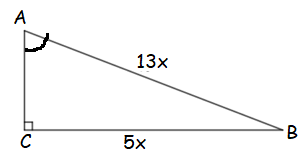
AB = 13x, BC = 5x
AC = √(13x)2 - (5x)2
AC = √169x2 - 25x2
AC = √144x2
AC = 12x
AB = 26 = 13x
x = 2
Applying the value of x in 12x, we get
12x = 12(2) ==> 24 cm
Example 11 :
In the triangle given above, find the value tan C.
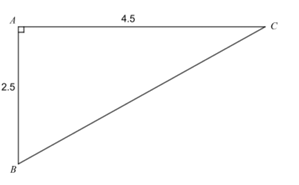
Solution :
tan C = Opposite side / adjacent side
AB = opposite side, AC = adjacent side
tan C = AB/AC
= 2.5/4.5
= 25/45
tan C = 5/9
So, the value of tan C is 5/9.
Subscribe to our ▶️ YouTube channel 🔴 for the latest videos, updates, and tips.
Kindly mail your feedback to v4formath@gmail.com
We always appreciate your feedback.
©All rights reserved. onlinemath4all.com
Recent Articles
-
10 Hard SAT Math Questions (Part - 37)
Dec 03, 25 07:02 AM
10 Hard SAT Math Questions (Part - 37) -
Factorial Problems and Solutions
Dec 02, 25 09:27 AM
Factorial Problems and Solutions -
10 Hard SAT Math Questions (Part - 36)
Nov 28, 25 09:55 AM
10 Hard SAT Math Questions (Part - 36)

